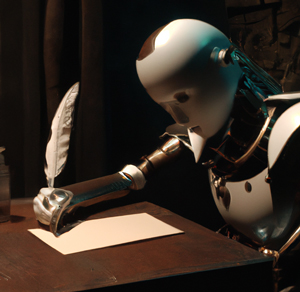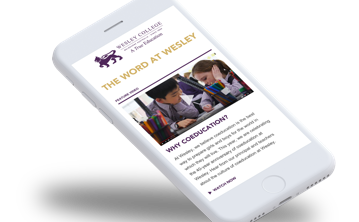Thirty years ago, Wesley College introduced the laptop program to support student learning in an increasingly technological environment. We recognised then that preparing our young people for the world of tomorrow requires methods that are different to the past. Today, it’s generative artificial intelligence (AI) programs like ChatGPT and DALL-E that are shaping the future of work and education and challenging the way that we teach and assess student learning.
The Wesley Lion
Scroll to see how AI image generator, DALL-E-2, interpreted the Wesley Lion in our logo

The Wesley Lion - in metal

A science fiction style Wesley Lion

The Wesley Lion as a mosaic

The Wesley Lion in the cubist style

The Wesley Lion in the surrealist style

Nick Evans, Wesley College Principal, says, ‘We are open to embracing the opportunity across our community to learn about, with and from this rapidly advancing technology. Whether it is text, image, audio or other forms of generative AI, we recognise that this is the next wave of technological and digital evolution which will develop in much the same way that personal devices have evolved over the last three decades.’
Hello ChatGPT, please write a lively 60-word introduction to an article about yourself and the impact you could have in education…
 Meet ChatGPT, the language model that’s revolutionizing education. With a vast knowledge base and cutting-edge natural language processing abilities, ChatGPT can assist students and teachers in ways never before possible. From answering complex questions to generating personalized learning content, ChatGPT has the potential to transform education and make learning more engaging, efficient, and effective than ever before. Get ready to discover the power of ChatGPT!
Meet ChatGPT, the language model that’s revolutionizing education. With a vast knowledge base and cutting-edge natural language processing abilities, ChatGPT can assist students and teachers in ways never before possible. From answering complex questions to generating personalized learning content, ChatGPT has the potential to transform education and make learning more engaging, efficient, and effective than ever before. Get ready to discover the power of ChatGPT!
What do you think? It can clearly write advertising copy, but how does it perform as an educational tool? What opportunities does it present, and how might it be a threat? And what, exactly, is ChatGPT?
Image: Created by DALL-E, an image-generating AI
Let’s deal with that last question first:
ChatGPT is a generative artificial intelligence, meaning it uses machine learning algorithms to generate original responses to prompts that you give it. It does this using a combination of statistical patterns and semantic understanding of language, based on its ‘training data’ – vast amounts of textual data it accesses on the internet. Essentially, it draws on textual patterns to predict what words would be used to answer a prompt on any given topic.
It has broad functionality: research tool, language translator, tone analyser, language modeller, text summariser, and content generator - on virtually any subject, in any writing form, and any style. And its ‘Chatbot’ function mediates your interactions with it – it holds the context of your exchanges, enabling remarkably sophisticated and nuanced conversations between human and machine.
According to David Howard, Head of Digital Learning and Practice at Wesley, this has enormous potential for personalised learning. ‘The response given to the student is custom for that student, who can then ask follow-up questions for further depth or explanation, a stark difference to students using traditional search engines’ he says.
Other potential benefits for students that David sees include its use as a revision tool, a creative outlet, a generator of sample essays and responses, and as a provider of immediate feedback on student work.
For teachers, there are additional benefits in lesson delivery and assessment – virtually instantly, it can generate ideas for lesson plans, questioning methods and thinking routines, as well as rubrics and assessment criteria, and comments for assessment and reporting.
Freely available to the public since its release in November last year, ChatGPT has become very popular, very quickly. In these early days of use, just what sort of impact is it making at Wesley, and what does it mean for our teaching and learning into the future?
Hear from our educators
Here a range of Wesley educators share their own report cards on the ChatGPT experience so far…
LANGUAGES – ELLEN MOFFAT
 There are several ways that I envisage using ChatGPT to reimagine assessment and further the teaching and learning of languages. This includes using ChatGPT to generate a stimulus text in French with deliberate content or language errors for students to identify and correct. It can also be used to randomise the order of information for students to put back together in a logical sequence to demonstrate their linguistic knowledge and understanding.
There are several ways that I envisage using ChatGPT to reimagine assessment and further the teaching and learning of languages. This includes using ChatGPT to generate a stimulus text in French with deliberate content or language errors for students to identify and correct. It can also be used to randomise the order of information for students to put back together in a logical sequence to demonstrate their linguistic knowledge and understanding.
ChatGPT behaves in foreign languages the same way as it does in English. The user can ask a question either in English or another language and ask for a response in the language of their choosing. While the accuracy of the response is not always perfect, it is good. With more interaction, content and feedback from users, I’m sure we’ll see the quality and accuracy of ChatGPT’s language skills improve with time. En avant!
ENGLISH AND LITERATURE – BEN BRUIN

ChatGPT will shape the nature of assessment in years to come by encouraging educators to create authentic assessments that focuses more on the application of skill rather than the memorisation and regurgitation of content.
It’s a valuable research tool, responding to student questions instantly, satisfying their knowledge and enabling them to move forward in their inquiry cycle at their own pace. For example, we recently used ChatGPT in a Year 9 class on Orwell’s Animal Farm to better understand communism, allegory, satire, propaganda, the short history of the Russian Revolution, and the key figures involved. Moreover, when asked, it pointed out several connections between the nefarious methods employed by those in power in the novella and those in power in Russia today.
Students quickly learned however, that the sources from which ChatGPT draws information are not always reliable, and what may appear to be ‘fact’ needs to be cross-checked and verified. These are very important digital literacy skills. In short, at present, the program can be wildly inaccurate. On numerous occasions, we laughed at how way off the mark it was about the texts we study – it sounded like someone who has clearly not read the text!
PHILOSOPHY – BEN REEVES
 We would all do well to remember the ‘garbage in, garbage out’ principle: the quality of the output is dependent on the quality of the input. Philosophy teacher Ben Reeves encourages his students to be the agents of their own learning, and in this context, sees ChatGPT as a useful tool in helping students develop the skill of knowing how to ask a question. Without this skill, accessing relevant and accurate information from AI tools will be problematic. As he says, ‘The future belongs to those who know what questions they want to ask.’
We would all do well to remember the ‘garbage in, garbage out’ principle: the quality of the output is dependent on the quality of the input. Philosophy teacher Ben Reeves encourages his students to be the agents of their own learning, and in this context, sees ChatGPT as a useful tool in helping students develop the skill of knowing how to ask a question. Without this skill, accessing relevant and accurate information from AI tools will be problematic. As he says, ‘The future belongs to those who know what questions they want to ask.’
The growing presence of generative AI in everyday life has, however, provided a rich source of discussion topics for the philosophy classroom, according to Ben. ‘We can use ChatGPT to spark many discussions. Can machines think? What is the nature of consciousness? What skills and capabilities make us human? Which ones can we use to add value to the world that a machine can’t?’
GEOGRAPHY AND HISTORY – ILJA VAN WERINGH

According to Geography and History teacher and Head of Teaching and Learning, Ilja Van Weringh, ChatGPT has limited ability to analyse information within a given context. ‘AI tools are simply another addition to the writing and thinking toolbox, like Wikipedia and Google,’ she says. ‘These tools are of great help, but they will not replace the need for critical thinking, analysis and evaluation. For example, if you ask ChatGPT the causes of World War I, it can list multiple factors, but can’t analyse or interpret these for a particular context.
‘If students were to copy and paste text from ChatGPT, they would likely get quite a low mark because it often lacks critical analysis, specific references to the content and sometimes, even blatant factual errors. On the flip side, this makes ChatGPT useful as a writing assistant. Teachers or students can use ChatGPT to generate a standard response, then the students can apply analysis, evaluation and examples to deepen the response.’
ECONOMICS – CHRIS MARSDEN

One of the benefits of ChatGPT is that it can show students how to structure responses to questions. The more challenging economics examination questions often require students to discuss or evaluate the effectiveness of a policy. There tends to be a logical structure and approach when addressing these types of questions and ChatGPT can be used to provide a neat collection of sample essays that students can analyse and discuss.
Sometimes referred to as the ‘King of Pastiche’, it's very good at cutting and pasting ideas together in a particular style - in this case, an academic writing style. An important aspect in writing economic analysis is what I refer to as the ‘language of discussion’ or ‘the language of evaluation’. ChatGPT texts provide a huge number of sample sentences that exemplify these forms.
BUSINESS MANAGEMENT - LEEANNE SMITH

ChatGPT is a great resource for initial research. It can help students structure a response and describe business management concepts, models and terms. However, it doesn’t analyse or apply theory to specific cases and business scenarios.
For Economics it tends to be general but a solid starting point for students to build from. However, there are drawbacks. Economics is a highly technical subject, and many of its concepts are math-based. ChatGPT is not adept at providing detailed explanations for concepts that have a strong foundation in mathematics. It has very limited ability to interpret, evaluate or find inference in data, modelling, graphs etc, and it cannot contextualise answers for a particular question or situation, which means answers may be too general, incomplete or inaccurate.
SCIENCE - GRANT EYLES
 Applications in the science classroom are broad: answering student questions on science topics, generating discussion topics, providing explanations for scientific concepts, creating puzzles and quizzes, and encouraging critical thinking by generating open-ended questions.
Applications in the science classroom are broad: answering student questions on science topics, generating discussion topics, providing explanations for scientific concepts, creating puzzles and quizzes, and encouraging critical thinking by generating open-ended questions.
Tasks such as essays and self-designed experiments can benefit during the initial planning stage by asking the bot to design a response using set parameters of the task. This step is little different to finding previous work on the net. Students then use it as a starting point in designing their own response.
ChatGPT can never replace the hands-on element – it’s an essential part of the learning process for science students. Science is founded on practical experimentation – the central role of conducting experiments in the lab or out in the field is currently way beyond the capabilities of any AI.
ART – MICHELE MAHER

Through their learning, visual art students need to demonstrate process, ideation and conceptualisation, technical skills, development of the art, coherence, and presentation of folios. DALL-E (the visual art equivalent of ChatGPT) lacks all of these opportunities for learning! Art is a practical and creative pursuit, requiring practice and learning from mistakes in order to develop and grow. In art class, we try to ‘slow students down’ to make room for creative thinking - we deliberately take students off laptops and devices, and students work in the particular medium selected.
DALL-E is a machine learning algorithm and lacks the creative agency and intuition that human artists possess. The images it generates lack the nuance, intentionality, and artistic expression that comes with human artmaking.
MEDIA STUDIES – KARISSA ROBERTSON

DALL-E could have a place in media studies and visual communication, particularly in storyboarding and visualisation applications for film and product development. Students can draft their visual ideas at the early stages of the development process using DALL-E images –with the ‘robot’ taking care of the lower-order levels of the process.
Students have to show their work (choosing shot size, camera angles, movements, spatial framing etc) and it needs to be authenticated by us, but there's no need for them to actually draw the storyboards themselves. In principle, storyboarding is something that could be done through generative AI, however there's still debate about that amongst the media studies fraternity.
MATHEMATICS - HELEN FAULKNER

Dr Helen Faulkner sees a place for ChatGPT in the mathematics classroom but isn’t confident it can handle high levels of complexity. As a language model, its strengths lie in generating natural language responses to prompts, but it lacks the ability to manipulate numbers and equations with the precision and insight of a mathematician. Where it may provide potential benefit is in setting questions and mathematics problems. For example, teachers could use it to generate a question about parabolas for a Year 10 exam.
The International Baccalaureate’s Head of Assessment Principles and Practice, Matt Glanville, believes the ‘chatbot’ should be embraced as an ‘extraordinary opportunity,’ but recognises that writing may feature less prominently in the qualifications process in the future because of the rise of this type of technology.
‘When AI can essentially write an essay at the touch of a button, we need students to master different skills, such as understanding context, bias and creativity. These will be far more important than simply writing an essay, so the assessment tasks we set will need to reflect this,’ he said. As with any quote or material adapted from another source, it will need to be credited in the body of the text and appropriately referenced in the bibliography.
So as a teaching and learning community, where does this lead us? How do we prepare our students to flourish in an evolving digital landscape so full of opportunities and threats? While AI can’t yet replicate our curiosity, creativity, or critical thinking, it will impact almost every job...
Wesley’s Director of Learning, Cameron Paterson, sees the promise in generative AI rather than the drawbacks: ‘Just as previous generations learned to work with different tools, the next generation will learn to work with AI and robots. Young people, who are better equipped to understand the opportunities AI provides, will lead the charge in developing new, innovative ways to utilise it,’ he said.
‘Our competitive advantage is our ability to offer value beyond an algorithm like ChatGPT. AI will take care of the rote and mundane so we can focus on higher order skills. The robots can do the robotic stuff so we can be more human.’
